Welcome! Whether you are a current foster parent, considering becoming licensed, or somewhere in between, staying informed and aware of the current trends, myths, and information surrounding foster care is essential. Take a minute to read through these five myths, and feel free to share them with your network.
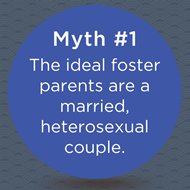 MYTH #1: The ideal foster parents are a married, heterosexual couple.
MYTH #1: The ideal foster parents are a married, heterosexual couple.
FACT: The ideal foster parent wants to parent children and can provide consistent love, support, and understanding for the youth in their care. Foster parents can be married, single, divorced, widowed, separated, cohabiting, etc., and sexual orientation does not negatively impact your ability to become a foster parent.
We’re looking for safe, stable, nurturing homes for children who have been traumatized. If you can provide that, we want you to join us.
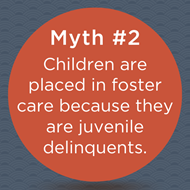 MYTH #2: Children are placed in foster care because they are juvenile delinquents.
MYTH #2: Children are placed in foster care because they are juvenile delinquents.
FACT: Children are placed in foster care because they are no longer safe in their current living environment. Foster children need consistent and patient care, just like any other children. There are many reasons that a child may enter foster care, including, but not limited to: abandonment, neglect, and parent illness or death.
Due to these challenging circumstances, many children who enter foster care have experienced trauma and may struggle with coping skills and general day-to-day living. It’s important that foster parents create a safe, calm, and predictable environment for their foster child and reach out for support when needed.
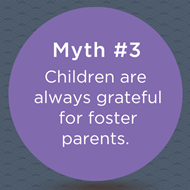 MYTH #3: Children are always grateful for foster parents.
MYTH #3: Children are always grateful for foster parents.
FACT: The reality of foster care is that each child will experience significant loss and change when removed from their home. It can be frightening to be separated from your family, not know where you will be placed next, or if you will be able to return home.
It’s important for foster parents to know this complex reality and not take it personally. Your love and support will make a difference in the lives of each child, especially if you provide unconditional love through the ups and downs of their journey.
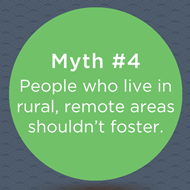 MYTH #4: People who live in rural, remote areas shouldn’t foster.
MYTH #4: People who live in rural, remote areas shouldn’t foster.
FACT: The reality is that foster care touches all parts of our country, not just major cities. It’s important that, when possible, kids remain in the communities where they are from. This helps ease the transition into foster care instead of forcing a child to leave their community, school, and friends. It’s important that we have foster homes available in all areas, urban and rural so that we can properly care for that child when the time comes.
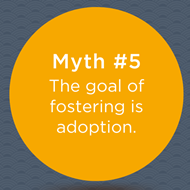 MYTH #5: The goal of fostering is adoption.
MYTH #5: The goal of fostering is adoption.
FACT: This one is important. The goal of fostering is reunification. We want to allow families to be reunited after steps have been taken to ensure the health and wellness of their family for all that reside in it. Reunification significantly improves outcomes for children and parents and is always the goal.
When reunification is not an option, placing children with an extended family member or kinship care is the goal. Adoption becomes an option when these reunification goals have not been met.
For more information, download our “Why Reunification?” infographic.



.png?mw=602&mh=505&sh=504bb)